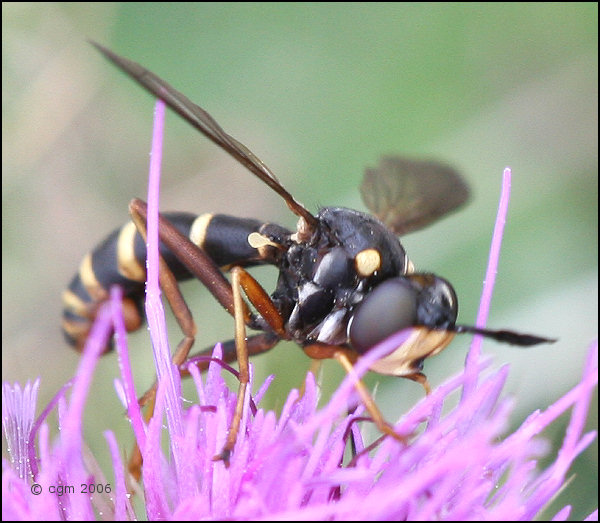Diptera.info :: Identification queries :: Diptera (adults)
Who is here? 1 guest(s)
|
Conops quadrifasciatus
|
|
| crex |
Posted on 19-08-2006 18:29
|
|
Member Location: Sweden Posts: 1996 Joined: 22.05.06 |
From today, aprox 65 km NW of Stockholm, Sweden. This fly popped up when I was concentrating on another insect on this flower. Only got this mediocre shot. I think it is a Syrphid, and not a Conopid? Edit: Changed subject (Unknown species) Edit: Changed subject (Conops sp) crex attached the following image:  [95.51Kb] Edited by crex on 20-08-2006 12:05 |
|
|
|
| lweit |
Posted on 19-08-2006 18:35
|
|
Member Location: France, Département de la Moselle Posts: 609 Joined: 23.12.05 |
Hello I think, it's not a syrph, it's a species of the family Conopidae maybe Conops quadrifasciatus Degeer, 1776 Louis Edited by lweit on 19-08-2006 18:36 |
|
|
|
| conopid |
Posted on 19-08-2006 20:47
|
|
Member Location: United Kingdom Posts: 1039 Joined: 02.07.04 |
I think it is more likely to be something like Conops flavipes - it is too dark for C quadrifasciatus. However there are probably other species in Europe that it could be.
Nigel Jones, Shrewsbury, United Kingdom |
|
|
|
| crex |
Posted on 20-08-2006 10:29
|
|
Member Location: Sweden Posts: 1996 Joined: 22.05.06 |
Thanx Louis and Nigel. I've googled for photos of the Conops found in Sweden, but I have trouble seeing which one fits ... Found in Sweden (Fauna Europaea): Conops flavipes (Linnaeus 1758) Conops quadrifasciatus (De Geer 1776) Conops strigatus (Wiedemann in Meigen 1824) Conops vesicularis (Linnaeus 1761) Edited by crex on 20-08-2006 10:35 |
|
|
|
| Tony Irwin |
Posted on 20-08-2006 11:25
|
|
Member Location: Norwich, England Posts: 7234 Joined: 19.11.04 |
I think the black frons, silvery pleural stripes, unthickened yellow legs and large yellow theca all suggest Conops quadrifasciatus. The females are much darker than the males.
Tony ---------- Tony Irwin |
|
|
|
| Zeegers |
Posted on 20-08-2006 11:50
|
|
Member Location: Soest, NL Posts: 18787 Joined: 21.07.04 |
I agree with Tony. C. quadrifasciatus is very variable. C. flavipes has always, surprisingly enough, strongly bicolorous hind femora: half yellow, half black. Theo Zeegers |
|
|
|
| crex |
Posted on 20-08-2006 12:06
|
|
Member Location: Sweden Posts: 1996 Joined: 22.05.06 |
Thank you very much T & T! |
|
|
|
| lweit |
Posted on 20-08-2006 14:13
|
|
Member Location: France, Département de la Moselle Posts: 609 Joined: 23.12.05 |
Hello What means theca ? This word is'nt in the glossary Thank you Louis |
|
|
|
| Tony Irwin |
Posted on 20-08-2006 15:13
|
|
Member Location: Norwich, England Posts: 7234 Joined: 19.11.04 |
The theca is a ventral projection on the fifth abdominal segment. Together with modified seventh and eighth segments they form a clasping organ which is used to hold onto the host bee while the egg is laid. The female theca may be very large, so that it may be mistaken for a male which has smaller genitalia. Good examples of the theca can be seen in Gerard's pictures - see http://www.dipter...hoto_id=35 and http://www.dipter...hoto_id=52. Edited by Tony Irwin on 20-08-2006 15:14 Tony ---------- Tony Irwin |
|
|
|
| Jump to Forum: |















